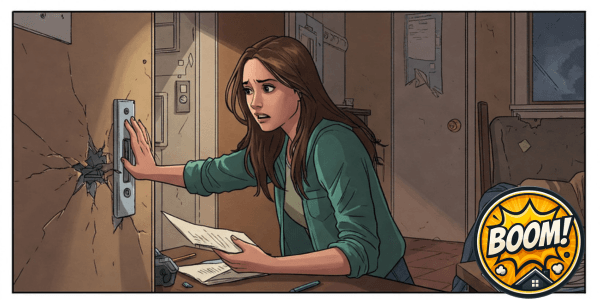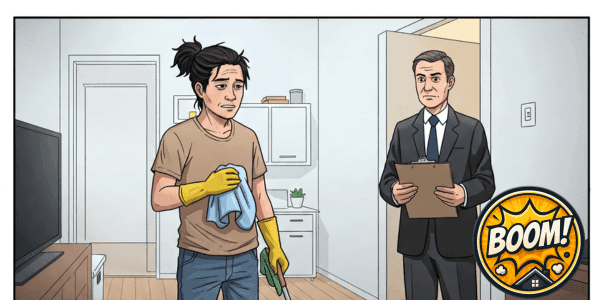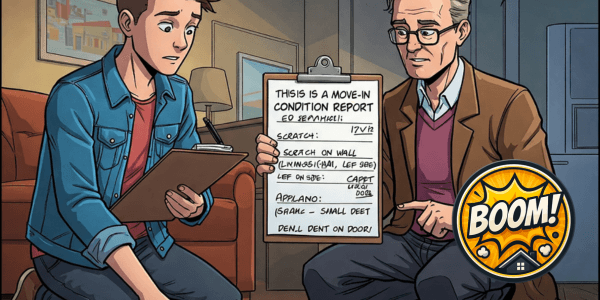Securing a Safe and Functional California Rental: Understanding Your Repair Rights

- Securing a Safe and Functional California Rental: Understanding Your Repair Rights
- What Conditions Legally Violate Habitability in California? (CC § 1941.1)
- Timelines for Landlord Repairs in California
- Initiating the Repair Process: The Importance of Formal Written Notice
- Building Your Case: The Critical Role of Documentation
- Landlord Not Responding? Understanding Your Legal Remedies (CA Civil Code § 1942)
- Working Towards Resolution: The Value of Process
- FAQ – Defining Uninhabitable
Dealing with a broken heater in winter, a persistent leak, or faulty wiring in your rental apartment isn’t just frustrating – it can be illegal. As a tenant in California, you have a fundamental right to a safe and livable home, a concept legally known as the “implied warranty of habitability.” This means your landlord has a legal duty to maintain your rental unit and make necessary repairs to ensure it meets basic living standards.
This right is embedded in every residential lease in the state, even if not explicitly written down, primarily under California Civil Code § 1941.1. But what exactly does “habitable” mean under the law? And what are your rights and options when your landlord fails to make essential California landlord repairs?
This guide will walk you through the specific conditions that legally define uninhabitable conditions in a California rental, explain your landlord’s responsibilities, and outline the crucial steps you need to take to get necessary repairs made, protecting both your comfort and your tenant rights California repairs.
What Conditions Legally Violate Habitability in California? (CC § 1941.1)
California law precisely defines the baseline requirements for a rental property to be considered habitable. According to [CA Civil Code § 1941.1], a rental unit may be deemed legally uninhabitable if it significantly lacks any of these critical elements:
- Protection from the Elements: The roof and exterior walls must effectively shield occupants from wind and rain. This includes ensuring windows and doors are intact and functional.
- Functional Plumbing System: The property must have operational plumbing that meets code standards, including the delivery of both hot and cold running water to necessary fixtures (like sinks and showers/tubs), all properly connected to an approved sewage disposal system.
- Safe Gas Service: If the property uses gas, all related lines and appliances must be maintained in safe, working condition.
- Adequate Heating: Functioning heating facilities are required and must be kept in good operational order. A non-working heater, especially in colder months, is often a high-priority issue.
- Reliable Electrical System: The unit must have safe electrical lighting, wiring, and equipment that complied with codes at the time of installation and continue to be maintained safely.
- Clean and Sanitary Premises: Both the building and its grounds must be kept reasonably clean and free from excessive garbage, debris, filth, rodents, and other vermin throughout the tenancy.
- Sufficient Trash Management: Appropriate and sufficient trash receptacles must be provided and kept in good condition.
- Sound Structural Elements: Floors, stairways, and railings must be maintained safely and in good repair, addressing more than just superficial aesthetic issues.
- Essential Security and Safety Devices: This includes required features like operable deadbolt locks on main entry doors, functional locking mechanisms on windows meant to open, and properly working smoke detectors (plus carbon monoxide detectors if required due to fuel-burning appliances or attached garages).
Key Consideration: The legal standard refers to a “substantial lack” of these features. Minor defects or cosmetic flaws usually don’t meet the threshold for legal uninhabitability. The issue must generally pose a significant threat to the tenant’s health or safety, rendering the unit uninhabitable.
Being aware of what makes a rental uninhabitable is crucial for tenants. Uninhabitable conditions can include significant issues such as persistent leaks, lack of heating, or unsafe electrical systems, all of which your landlord must address promptly to maintain the habitability of the rental unit.
Timelines for Landlord Repairs in California
These conditions highlight the importance of understanding your rights as a tenant when facing uninhabitable living situations. If you encounter uninhabitable circumstances, a quick response is vital to safeguarding your health and safety.
Once a habitability problem arises, how quickly must the landlord act? California law employs a “reasonable time” standard rather than assigning a fixed deadline for every repair. The urgency of the situation largely dictates what is considered reasonable.
- Urgent Issues (Impacting Health & Safety): Problems posing immediate health or safety risks demand swift action, often within a few days (sometimes as little as 24-72 hours). Examples include:
- Absence of hot/cold water
- Failure of heating during cold weather
- Major water leaks or sewage backups
- Dangerous electrical problems
- Suspected gas leaks
- Severe pest infestations (e.g., rats, widespread roaches)
- Broken locks on exterior doors or windows compromising security
- Non-Urgent (But Necessary) Repairs: For issues that affect habitability but aren’t immediate threats, the law often implies that 30 days is a reasonable timeframe for the landlord to address the problem after receiving formal notice. (This 30-day timeframe is referenced in the context of the “Repair and Deduct” remedy under Civil Code § 1942). Examples could include a malfunctioning essential appliance provided by the landlord, a broken interior door (if non-hazardous), or minor structural issues not posing immediate danger.
It’s vital to differentiate between true emergencies and significant inconveniences. While delays are frustrating, accurately representing the issue’s urgency in your communication is important. If a dispute arises, a court may ultimately determine what timeframe was “reasonable” for the specific circumstances. Always notify your landlord without delay, especially for pressing matters.
Initiating the Repair Process: The Importance of Formal Written Notice
Before pursuing legal remedies like “Repair and Deduct” or potentially ending your lease due to uninhabitability, the essential first step is to formally notify your landlord of the problem and grant them that “reasonable time” to fix it. While verbal notice might sometimes suffice legally, written notice is paramount.
Why Written Notice is Crucial:
- Provides Undeniable Proof: Creates a time-stamped record confirming when the landlord was informed about the specific defect.
- Ensures Clarity: Clearly articulates the problem, reducing potential misunderstandings.
- Fulfills Legal Prerequisites: Often required before a tenant can legally utilize specific remedies under California law.
Elements of Effective Written Notice:
- Your name, rental address, and the current date.
- Your landlord’s name and address (use the address provided in the lease or commonly used for communication).
- A precise and detailed explanation of the needed repair (e.g., “The furnace is failing to ignite and produce heat,” “Water is continuously leaking from the pipe beneath the bathroom sink,” “The locking mechanism on the bedroom window is broken”).
- A statement clarifying that this issue impacts the unit’s habitability and requires repair.
- A request for repairs within a reasonable period (mentioning the 30-day expectation for non-urgent issues or stressing the need for quicker action if it’s an emergency).
- Your contact details.
- Always keep a copy for your records!
Delivery Methods: Sending the notice via certified mail with a return receipt requested offers the strongest proof of delivery. Email can also be effective if it’s your standard method of communication with the landlord and not prohibited by your lease, but ensure you save a copy of the sent email. Following this formal procedure is far more productive than issuing immediate ultimatums.
Building Your Case: The Critical Role of Documentation
If you find yourself in an uninhabitable situation, it’s essential to document the issues thoroughly. Photographs and written records will support your claims if you need to take further action.
When facing repair issues, meticulous record-keeping is invaluable. Should your landlord contest the repair need, attempt to assign blame to you, or engage in unlawful retaliation, your documented evidence becomes essential.
Key Items to Document:
- Visual Evidence: Take clear photos or videos of the defect as soon as possible. Capture the extent of the problem. Dated photos/videos are ideal. Document any worsening of the condition over time.
- Communication Trail: Retain copies of all letters and emails exchanged with your landlord concerning the repair request and any responses received. Keep proof of mailing (like certified mail receipts).
- Conversation Log: If discussing the issue via phone or in person with the landlord or maintenance personnel, maintain a log. Record the date, time, person spoken to, and a brief summary of the conversation (e.g., “3/15/25, 10:00 AM – Spoke with Manager John Smith re: leaking faucet. He stated he would schedule a plumber.”).
- Financial Records: If you utilize the “Repair and Deduct” option (explained below), keep highly detailed invoices and receipts for all labor and materials.
- Move-In Condition Report: Refer back to your initial move-in checklist. This document establishes the property’s condition when you first occupied it and can help demonstrate if a problem predates your tenancy or is due to normal wear and tear.
Comprehensive documentation creates a clear timeline and paper trail, significantly strengthening your position if the dispute requires formal action, such as a small claims court filing or defending against unwarranted charges.
Landlord Not Responding? Understanding Your Legal Remedies (CA Civil Code § 1942)
You’ve provided proper written notice, allowed a reasonable time for action, documented everything meticulously, yet the necessary repairs remain undone. What are your options? California law offers several potential remedies, primarily under [CA Civil Code § 1942 – official legislative info site], but using them correctly is vital.
Prerequisites for Using Tenant Remedies:
- You must have given the landlord proper written notice.
- You must have allowed a legally “reasonable time” for the repair.
- You must have documented the problem and your communication attempts.
- The issue must be a genuine habitability defect the landlord is responsible for fixing.
- You or your guests must not have caused the problem through misuse or negligence.
Available Legal Options:
- Repair and Deduct: (CC § 1942) This remedy allows you, under specific conditions, to arrange and pay for the repair yourself and then subtract that cost from your subsequent rent payment.
- Cost Constraint: The repair cost cannot exceed one month’s rent.
- Usage Limit: This option can only be used twice within any 12-month period.
- Procedure: Obtain the necessary repairs (use a qualified professional if needed), pay the bill, keep detailed receipts, and deduct the precise amount from your next rent payment. When paying the reduced rent, provide your landlord with copies of the receipts and a clear written explanation for the deduction.
- Heads Up: Even when used correctly, some landlords might challenge the deduction. Your thorough documentation is your defense.
- Abandonment (Moving Out): (CC § 1942) If the defects are so severe that they render the unit uninhabitable, and the landlord has failed to act after proper notice and reasonable time, the law permits you to vacate the premises (abandonment).
- Consequences: If you properly abandon the unit under this provision, you are relieved of the obligation to pay further rent, and your lease agreement is terminated as of your move-out date (ensure you return keys).
- Procedure: Notify your landlord in writing that you are vacating under Civil Code § 1942 due to the uninhabitable conditions, specifying your move-out date. Promptly return the keys.
- Heads Up: This remedy should only be invoked for truly serious habitability issues. If a landlord disagrees that the conditions justified abandonment, they might sue for the remaining rent owed under the lease. Strong evidence (photos, videos, potentially reports from code enforcement) is critical.
- Rent Withholding (Proceed with Extreme Caution): Tenants often inquire about simply stopping rent payments until repairs are made. While withholding rent can sometimes serve as a legal defense against eviction if severe habitability problems exist, this is generally the riskiest path for a tenant.
- Significant Risk: Failure to pay rent will almost certainly trigger a 3-Day Notice to Pay Rent or Quit from the landlord, quickly followed by an eviction lawsuit (Unlawful Detainer).
- Legal Complexity: Merely stopping payment typically offers no legal protection. To potentially use this defensively in court, the habitability defect must be substantial, proper notice and reasonable time must have been given, and courts often look favorably on tenants who can prove they set aside the withheld rent (e.g., in an escrow account, though establishing one might require court involvement). Successfully defending against eviction based on withheld rent requires strict adherence to legal procedures and strong evidence.
- Seek Legal Counsel First: Never withhold rent without first consulting an experienced tenant rights attorney or a reputable legal aid organization [LawHelpCA.org]. They can evaluate your specific circumstances, explain the considerable risks, and advise whether this strategy is feasible. Missteps here can lead to eviction and severely damage your rental history.
- Formal Complaints and Lawsuits:
- Legal Action: You can initiate a lawsuit against your landlord, often in Small Claims Court. You can ask the court to order the landlord to complete the repairs and potentially award monetary damages (e.g., a partial rent refund for the time the unit was defective, reimbursement for related costs you incurred). Strong documentation is essential for success in court.
- Reporting Violations: Contact your local city or county authorities (Building Department, Health Department, Code Enforcement). An official inspection can document violations and result in the agency issuing formal orders to the landlord to make corrections. This creates an official record and applies external pressure.
Working Towards Resolution: The Value of Process
To successfully resolve Landlord Repairs and ensure your rental remains a habitable space, tenants must blend an understanding of their rights with effective communication and documentation. While delays can be challenging, a methodical approach yields better results. Start by promptly communicating any issues, always following up with formal written notice. This written record, coupled with detailed documentation, is invaluable—it clarifies the scope of the problem for your landlord, aids in prioritization and tracking, and provides essential evidence.
Living in uninhabitable conditions is unacceptable, and thankfully, tenants have legal options to advocate for a safe living environment. Knowing these rights and legal channels is crucial. By consistently knowing your rights, communicating clearly and professionally in writing, and keeping thorough records, you build a strong foundation to ensure your landlord fulfills their responsibilities and your California rental is truly a safe and habitable home.
Disclaimer: This article provides general information based on common practices and specific data shared, and touches on California law . Landlord-tenant laws and specific charges vary by location and lease terms, and laws can change. Consult your specific lease agreement and local/state laws for definitive legal information. This is not a substitute for legal advice from a qualified attorney.
FAQ – Defining Uninhabitable
How long does my landlord legally have to make repairs in California?

California law doesn’t set a single fixed deadline for all repairs. Instead, it requires landlords to act within a “reasonable time” after being properly notified. What’s “reasonable” depends heavily on the severity of the problem. Urgent issues affecting health and safety (like no heat in winter, lack of hot water, major leaks, or security risks) require very fast action, often within days or even 24-72 hours. For less critical, non-urgent habitability issues, the law generally presumes 30 days is a reasonable timeframe for the landlord to act after receiving your formal written notice
What are some basic conditions required for my California rental to be legally habitable?

According to California Civil Code § 1941.1, your rental unit must meet several minimum standards to be considered habitable. Key requirements include effective weatherproofing (functional roof, walls, windows, doors), working plumbing with both hot and cold running water, safe electrical and gas systems (if applicable), functioning heating facilities, premises kept clean and free from pests and excessive garbage, adequate trash receptacles, structurally sound floors/stairs/railings, and essential safety features like working door deadbolts, window locks, and smoke/CO detectors. A property might be legally uninhabitable if it substantially lacks one or more of these essential features
What is the first step I need to take if something in my rental needs fixing?

The most critical first step is to provide your landlord with formal written notice detailing the problem. While you might call them, written notice (like a letter sent via certified mail with return receipt requested, or sometimes email if that’s your normal communication method) creates a dated record proving they were informed. This notice should clearly describe the issue, state that it affects habitability, request repairs within a reasonable timeframe, and include your contact information. This formal notification is legally required before you can pursue most tenant remedies like “Repair and Deduct.”
Can I hire someone myself to fix a problem and deduct the cost from my rent in California?

Yes, California law (Civil Code § 1942) allows for a “Repair and Deduct” remedy, but under strict conditions. You can only use this if: 1) The issue affects habitability and the landlord is obligated to fix it. 2) You did not cause the problem. 3) You gave the landlord proper written notice and allowed a reasonable time for them to make the repair. 4) The repair cost does not exceed one full month’s rent. 5) You use this remedy no more than twice in any 12-month period. If you meet all criteria, you can pay for the repair and deduct the exact cost, providing receipts to your landlord with your reduced rent payment
Other Articles by Louis Oconnor
Completing Your Move-In Condition Report | Free Guide
Landlord Not Renewing Lease? Understanding Your Rights | Free
Move-Out Inspection: What Your Landlord Is Really Looking For | Free Guide


